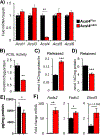Myeloid-Specific Deficiency of Long-Chain Acyl CoA Synthetase 4 Reduces Inflammation by Remodeling Phospholipids and Reducing Production of Arachidonic Acid-Derived Proinflammatory Lipid Mediators
- PMID: 34725110
- PMCID: PMC8802997
- DOI: 10.4049/jimmunol.2100393
Myeloid-Specific Deficiency of Long-Chain Acyl CoA Synthetase 4 Reduces Inflammation by Remodeling Phospholipids and Reducing Production of Arachidonic Acid-Derived Proinflammatory Lipid Mediators
Erratum in
-
Correction: Myeloid-Specific Deficiency of Long-Chain Acyl CoA Synthetase 4 Reduces Inflammation by Remodeling Phospholipids and Reducing Production of Arachidonic Acid-Derived Proinflammatory Lipid Mediators.J Immunol. 2022 Jun 1;208(11):2593. doi: 10.4049/jimmunol.2200133. Epub 2022 May 16. J Immunol. 2022. PMID: 35577369 No abstract available.
Abstract
In response to infection or tissue damage, resident peritoneal macrophages (rpMACs) produce inflammatory lipid mediators from the polyunsaturated fatty acid (PUFA), arachidonic acid (AA). Long-chain acyl-CoA synthetase 4 (ACSL4) catalyzes the covalent addition of a CoA moiety to fatty acids, with a strong preference for AA and other PUFAs containing three or more double bonds. PUFA-CoA can be incorporated into phospholipids, which is the source of PUFA for lipid mediator synthesis. In this study, we demonstrated that deficiency of Acsl4 in mouse rpMACs resulted in a significant reduction of AA incorporated into all phospholipid classes and a reciprocal increase in incorporation of oleic acid and linoleic acid. After stimulation with opsonized zymosan (opZym), a diverse array of AA-derived lipid mediators, including leukotrienes, PGs, hydroxyeicosatetraenoic acids, and lipoxins, were produced and were significantly reduced in Acsl4-deficient rpMACs. The Acsl4-deficient rpMACs stimulated with opZym also demonstrated an acute reduction in mRNA expression of the inflammatory cytokines, Il6, Ccl2, Nos2, and Ccl5 When Acsl4-deficient rpMACs were incubated in vitro with the TLR4 agonist, LPS, the levels of leukotriene B4 and PGE2 were also significantly decreased. In LPS-induced peritonitis, mice with myeloid-specific Acsl4 deficiency had a significant reduction in leukotriene B4 and PGE2 levels in peritoneal exudates, which was coupled with reduced infiltration of neutrophils in the peritoneal cavity as compared with wild-type mice. Our data demonstrate that chronic deficiency of Acsl4 in rpMACs reduces the incorporation of AA into phospholipids, which reduces lipid mediator synthesis and inflammation.
Copyright © 2021 by The American Association of Immunologists, Inc.
Figures





Similar articles
-
Long-chain acyl-CoA synthetase 4 participates in the formation of highly unsaturated fatty acid-containing phospholipids in murine macrophages.Biochim Biophys Acta Mol Cell Biol Lipids. 2019 Nov;1864(11):1606-1618. doi: 10.1016/j.bbalip.2019.07.013. Epub 2019 Jul 31. Biochim Biophys Acta Mol Cell Biol Lipids. 2019. PMID: 31376475
-
A role for long-chain acyl-CoA synthetase-4 (ACSL4) in diet-induced phospholipid remodeling and obesity-associated adipocyte dysfunction.Mol Metab. 2018 Mar;9:43-56. doi: 10.1016/j.molmet.2018.01.012. Epub 2018 Jan 31. Mol Metab. 2018. PMID: 29398618 Free PMC article.
-
Role of acyl-CoA synthetase ACSL4 in arachidonic acid metabolism.Prostaglandins Other Lipid Mediat. 2019 Oct;144:106363. doi: 10.1016/j.prostaglandins.2019.106363. Epub 2019 Jul 12. Prostaglandins Other Lipid Mediat. 2019. PMID: 31306767 Review.
-
Gene deletion of long-chain acyl-CoA synthetase 4 attenuates xenobiotic chemical-induced lung injury via the suppression of lipid peroxidation.Redox Biol. 2023 Oct;66:102850. doi: 10.1016/j.redox.2023.102850. Epub 2023 Aug 12. Redox Biol. 2023. PMID: 37586249 Free PMC article.
-
Polyunsaturated fatty acid-phospholipid remodeling and inflammation.Curr Opin Endocrinol Diabetes Obes. 2015 Apr;22(2):112-8. doi: 10.1097/MED.0000000000000138. Curr Opin Endocrinol Diabetes Obes. 2015. PMID: 25692925 Review.
Cited by
-
Arachidonic acid metabolism in health and disease.MedComm (2020). 2023 Sep 20;4(5):e363. doi: 10.1002/mco2.363. eCollection 2023 Oct. MedComm (2020). 2023. PMID: 37746665 Free PMC article. Review.
-
Keratinocyte-derived small extracellular vesicles supply antigens for CD1a-resticted T cells and promote their type 2 bias in the context of filaggrin insufficiency.Front Immunol. 2024 Mar 22;15:1369238. doi: 10.3389/fimmu.2024.1369238. eCollection 2024. Front Immunol. 2024. PMID: 38585273 Free PMC article.
-
CD8+ T cells and fatty acids orchestrate tumor ferroptosis and immunity via ACSL4.Cancer Cell. 2022 Apr 11;40(4):365-378.e6. doi: 10.1016/j.ccell.2022.02.003. Epub 2022 Feb 24. Cancer Cell. 2022. PMID: 35216678 Free PMC article.
-
The Crosstalk Between Ferritinophagy and Ferroptosis in Ischemic Stroke: Regulatory Mechanisms and Therapeutic Implications.Cell Mol Neurobiol. 2025 Jul 20;45(1):73. doi: 10.1007/s10571-025-01593-7. Cell Mol Neurobiol. 2025. PMID: 40684405 Free PMC article. Review.
-
Targeting ferroptosis and ferritinophagy: new targets for cardiovascular diseases.J Zhejiang Univ Sci B. 2024 Jan 15;25(1):1-22. doi: 10.1631/jzus.B2300097. J Zhejiang Univ Sci B. 2024. PMID: 38163663 Free PMC article. Review.
References
-
- Wang J, and Kubes P. 2016. A Reservoir of Mature Cavity Macrophages that Can Rapidly Invade Visceral Organs to Affect Tissue Repair. Cell 165: 668–678. - PubMed
-
- Ajuebor MN, Das AM, Virág L, Flower RJ, Szabó C, and Perretti M. 1999. Role of Resident Peritoneal Macrophages and Mast Cells in Chemokine Production and Neutrophil Migration in Acute Inflammation: Evidence for an Inhibitory Loop Involving Endogenous IL-10. The Journal of Immunology 162: 1685–1691. - PubMed
Publication types
MeSH terms
Substances
Grants and funding
LinkOut - more resources
Full Text Sources
Molecular Biology Databases

